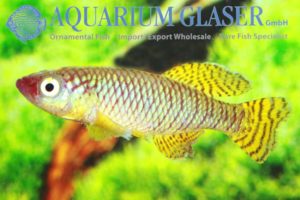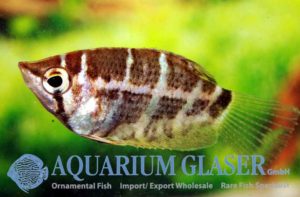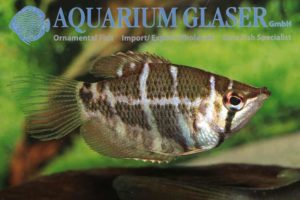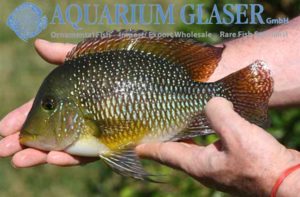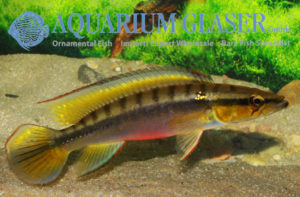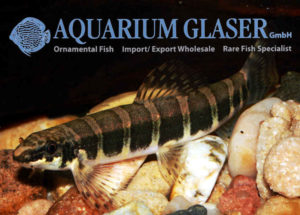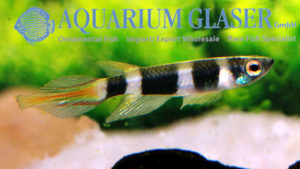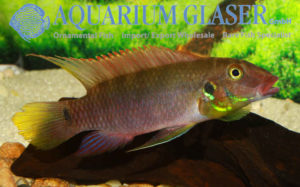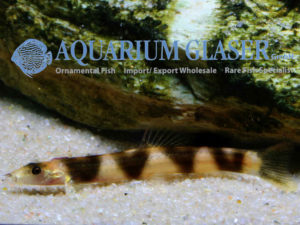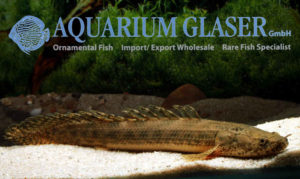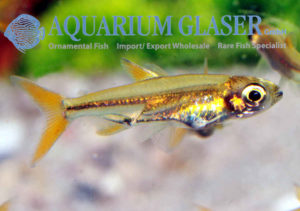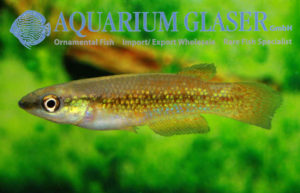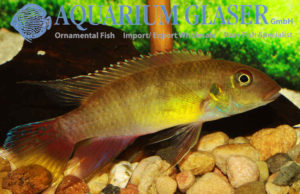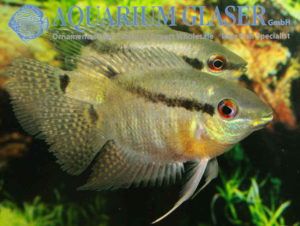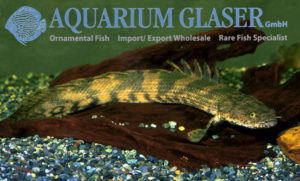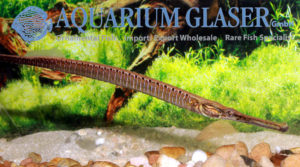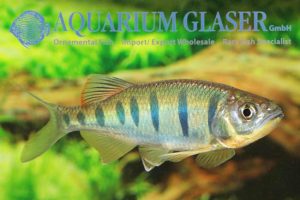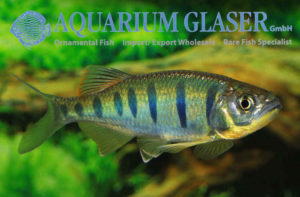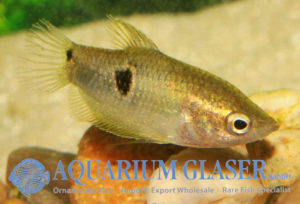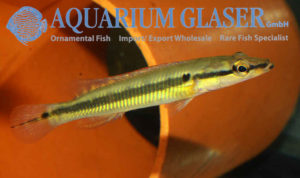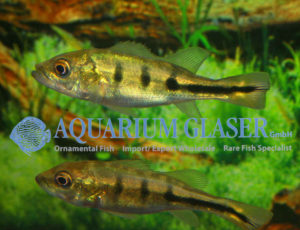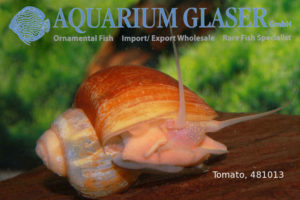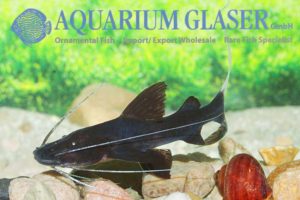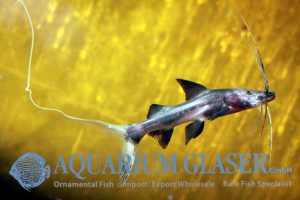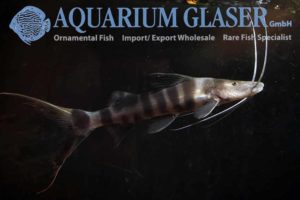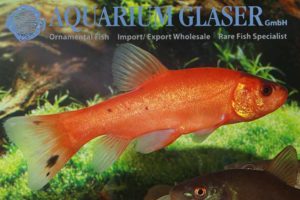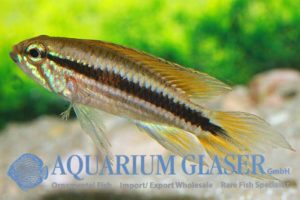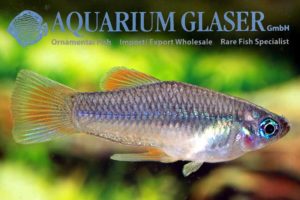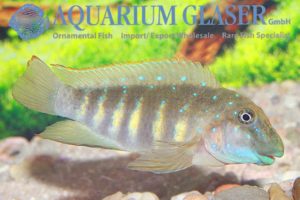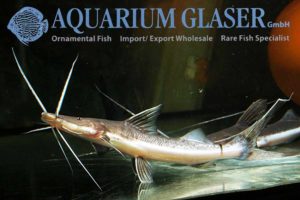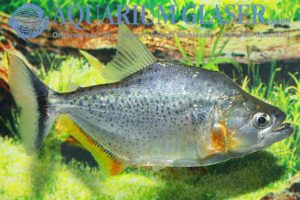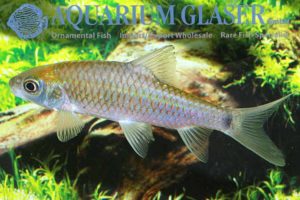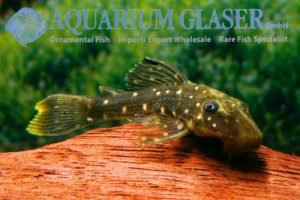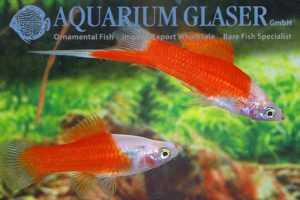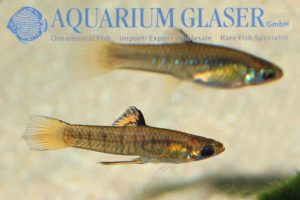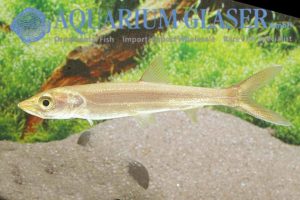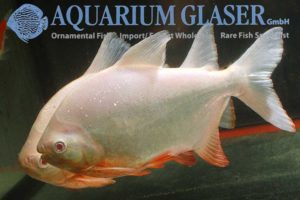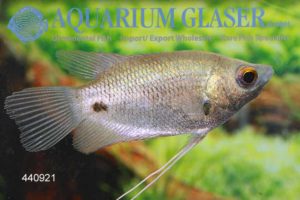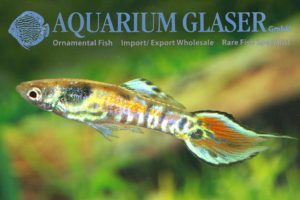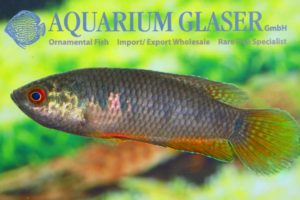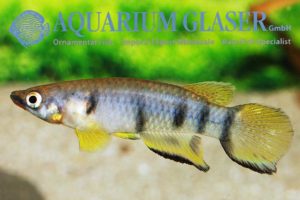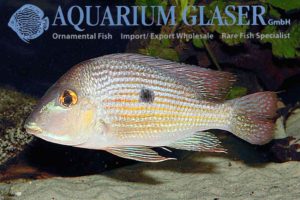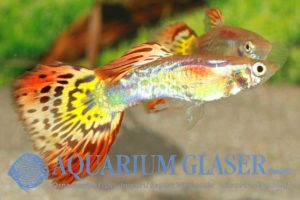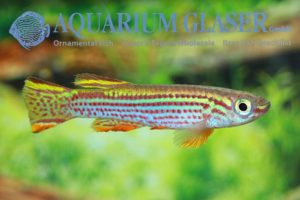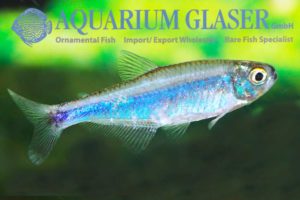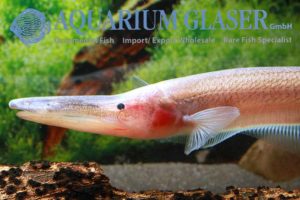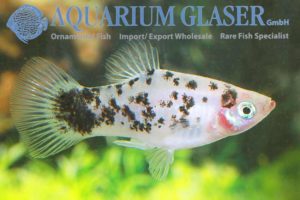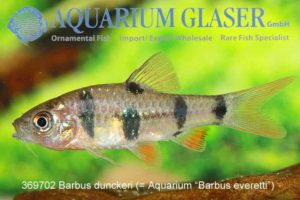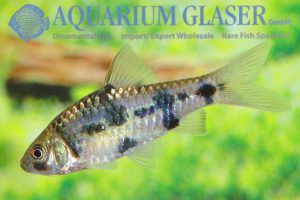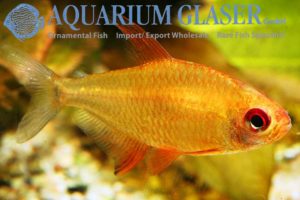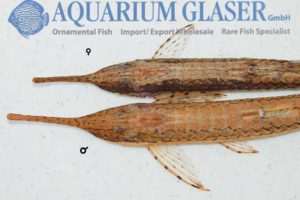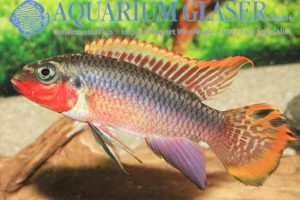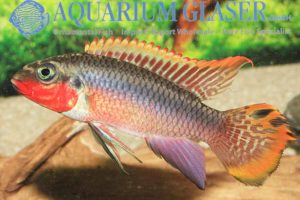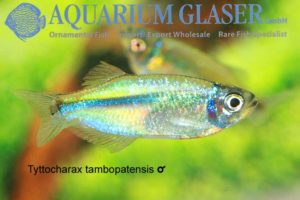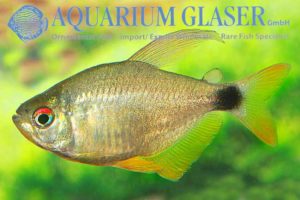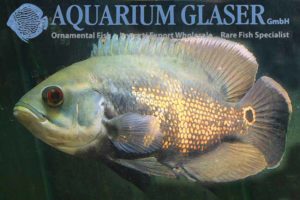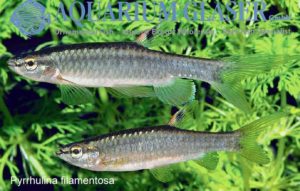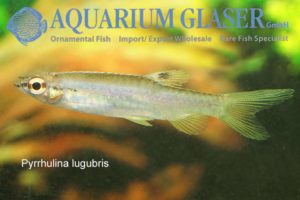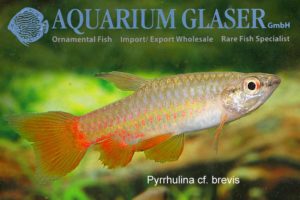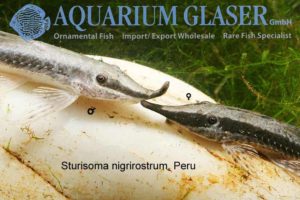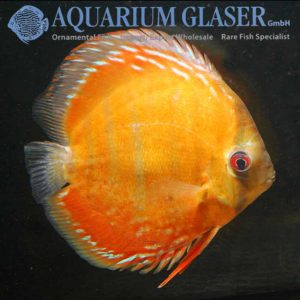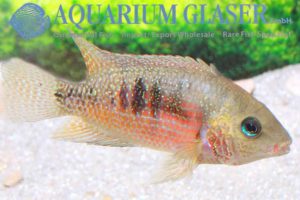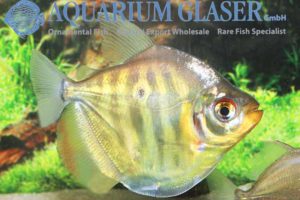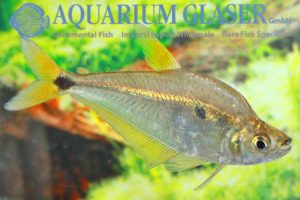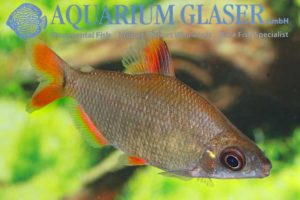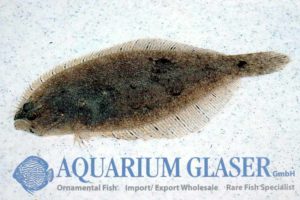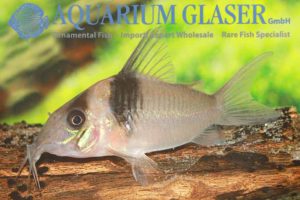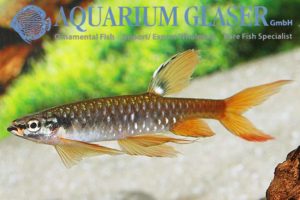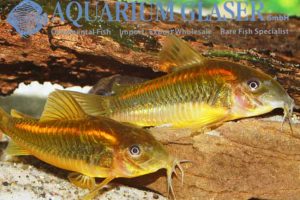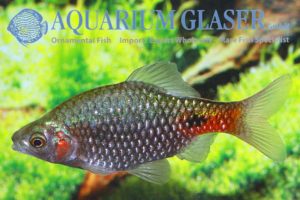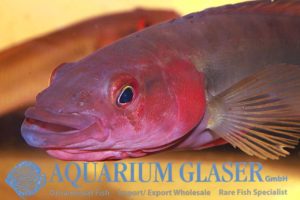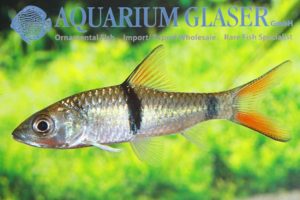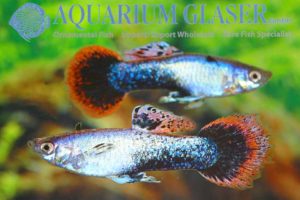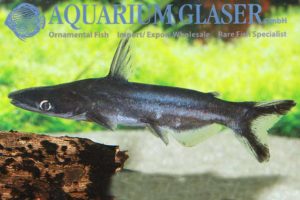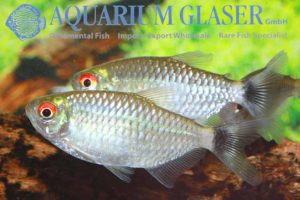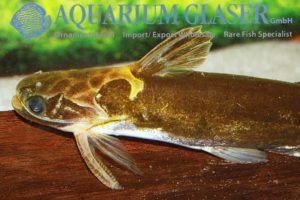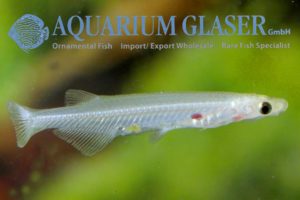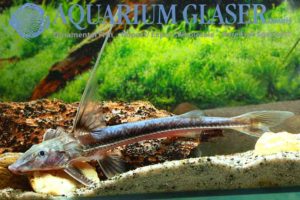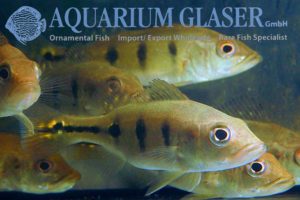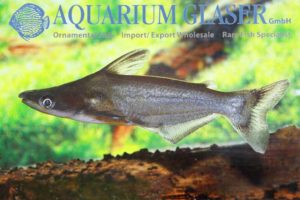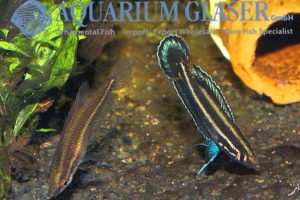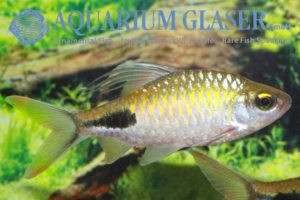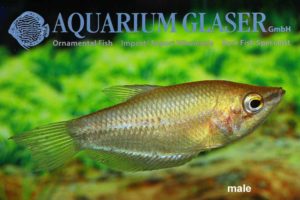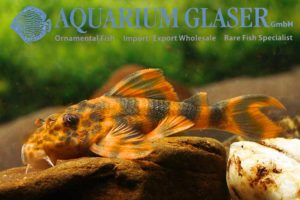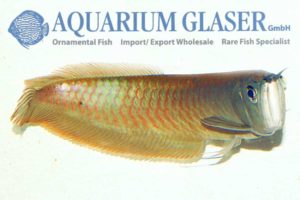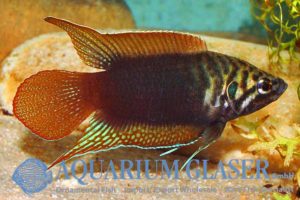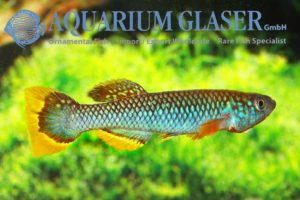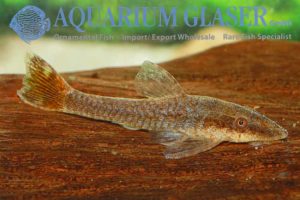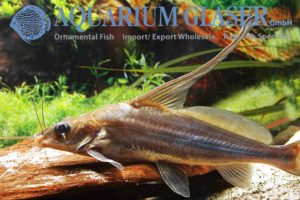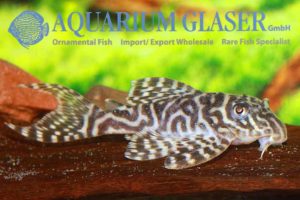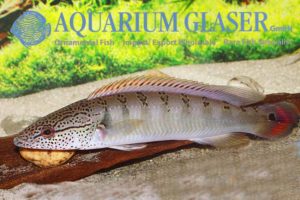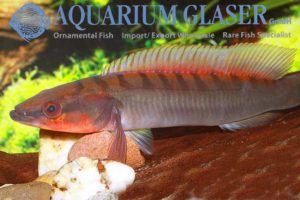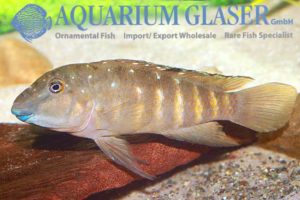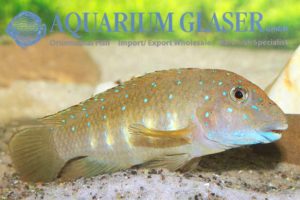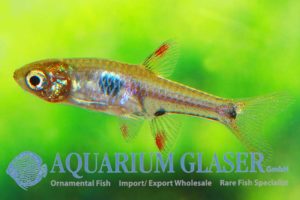We have received a very limited number of a new species of Nothobranchius from a German breeder. The species has been decribed scientifically in 2009 under the name of Nothobranchius ruudwildekampi. For our customers: the animals have code 338223 on our stocklist. Please note that we exclusively supply the wholesale trade. Text & photos: Frank […]
Fish Archive (3069)
-
-
Sphaerichthys selatanensis
We received beautiful, half-grown crossband-chocolate gouramis. The animals are very healthy! For our customers: the fish have code 455822 on our stocklist. Please note that we exclusively supply the wholesale trade. Text & photo: Frank Schäfer
-
Sphaerichthys selatanensis
With an overall length of 5 cm Sphaerichthys selatanensis is probably the smallest representative of the chocolate gouramis. It may recognized by its typical cross design. The species originates from Kalimantan in the southeast part of the island of Borneo. Like its relatives it lives in acidic black water brooks (at the discovery site measured […]
-
Geophagus brasiliensis MOGE / Uruguay
We received beautiful, very healthy German bred G. brasiliensis. The animals belong to a population from Uruguay and represent the first tank raised generation. The breeder provided to us photographs of the parents, which were taken immediately after collecting in Moge. The pictures show how splendid the fish will look like when they are grown […]
-
Crenicichla sp. VENTUARI
We received this extremely rare species from Venezuela. The fish is a comparatively small (maximum length observed so far is 16 cm), very colorful member of the Crenicichla-saxatilis-group. Available in very limited numbers only! For our customers: the fish have code 673053 on our stocklist. Please note that we exclusively supply the wholesale trade. Text […]
-
Serpenticobitis octozona
Currently we have extraodinary wonderful, adult, 4-6 cm long loches of that species, which is also traded under the name of “medusa loach”, in stock. For our customers: the fish have code 455012 on our stocklist. Please note that we exclusively supply the wholesale trade. Lexicon: Serpenticobitis: means “snake-Cobitis”; Cobitis is another genus of loach. […]
-
Pseudepiplatys annulatus CONAKRY
This tiny and charming little jewel becomes only 3-4 cm long. Our animals are wild collected specimens of the sport known in the hobby as the 'Conakry variety'. Read more on the species here: http://www.aquariumglaser.de/en/news/Pseudepiplatys_annulatus_en/ For our customers: the fish have code 322003 on our stocklist. Please note that we exclusively supply the wholesale trade. […]
-
Pelvicachromis rubrolabiatus FALSADE
This is another, very nice dwarf cichlid from western Africa, available even with the name of the collecting site. We have fully grown and wonderful coloured specimens in stock. For our customers: the fish have code 560363 on our stocklist. Please note that we exclusively supply the wholesale trade. Available in very limited numbers only! […]
-
Schistura pridii
We received very nice specimens of this nano-loach from Thailand – maximum length reported for the species is only 4.5 cm. Available in limited numbers only! For our customers: the fish have code 454982 on our stocklist. Please note that we exclusively supply the wholesale trade. Text & photos: Frank Schäfer
-
Polypterus ansorgii
We received only two specimens of this bichir – the rarest of all bichir species. The currently imported specimens are 15-20 cm long. The species can reach a maximum length of about 80 cm and thus represents the largest of all known Polypterus species. There appeared a German article on the species in the current […]
-
Ladigesia roloffi
This dwarf tetra (maximum length reported is 4 cm) is a real jewel from Westafrica. The fish love to swim. They should be kept in schools in a well planted aquarium. It is important to choose a dark gravel which makes the colours of the fish shine brightly. For our customers: the fish have code […]
-
Pachypanchax omanolotus
This beautiful panchax from Madagascar is only very occasionally available. Currently we could stock very nice German bred ones. For our customers: the fish have code 342202 on our stocklist. Please note that we exclusively supply the wholesale trade. Text & photos: Frank Schäfer
-
Pelvicachromis humilis LIBERIA RED
This beautiful sport of P. humilis is available only very occassionally. We received them in an ideal size (5-8 cm). They have already very nice colours! For our customers: the fish have code 559554 on our stocklist. Please note that we exclusively supply the wholesale trade. Available in limited numbers only! Lexikon: Pelvicachromis: the Latin […]
-
Mesonauta mirificus
For the first time ever we can offer these extraordinary nice flag cichlids as German bred (F1). The species originates from Peru. Available in limited numbers only! For our customers: the fish have code 683361 on our stocklist. Please note that we exclusively supply the wholesale trade. Text & photos: Frank Schäfer
-
Polypterus endlicherii GOLD
This large species – sexual maturity is reached at about 40 cm length, but the species can grow as big as 70 cm – is represented in Guinea by a very attractive colour variety that has a yellow-golden basic coloration (vs. ash-grey in others). For our customers: the fish have code 163215 on our stocklist. […]
-
Doryichthys boaja
Once more we were able to import the largest and most beautiful of all freshwater pipefish. This species occurs only in pure freshwater! Maximum size reported is around 40 cm. For our customers: the animals have code 414294 on our stocklist. Please note that we exclusively supply the wholesale trade. Text & photos: Frank Schäfer
-
Opsarius pulchellus
This is one of the most beautiful new entries in the hobby in the past few years. However, the species is known scientifically already since 1931, when Hugh M. Smith, one of the greatest experts for the fishes of Thailand, described the species. And even Smith observed the extraordinary beauty of the fish and named […]
-
Opsarius pulchellus
We received wonderful, about 6-8 cm long Opsarius pulchellus from Thailand. The common name “Butterfly danio” reflects perfectly all the beauty of this grace. Read more on the fish here: http://www.aquariumglaser.de/en/opsarius-pulchellus_de_1355.html For our customers: the animals have code 439904 on our stocklist. Please note that we exclusively supply the wholesale trade. Text & photos: Frank […]
-
Parasphaerichthys ocellatus
This extreme rarely imported species originates from Burma. The charming fish attains a length of only 2-3 cm. This is the only species of anabantoid fish whose way of reproduction is still unknown. The only other member of the genus, P. lineatus (see http://www.aquariumglaser.de/en/parasphaerichtys-lineatus_de_1211.html) is a bubblenest builder although the eggs look like the eggs […]
-
Crenicichla zebrina
For the first time ever we could import juveniles of this very rare species. For more information, please check: http://www.aquariumglaser.de/en/archiv.php?news_id=345
-
Cichla orinocensis
We currently have this amazing large cichlid in good numbers and an ideal size in stock. The specimens orginate from Venezuela and most of them are 3-5 cm long. This is a perfect size for the acclimatization of these fish in home aquaria. Besides this we also have a few specimens 5-7 cm long in […]
-
Apple Snails in many colours
Currently we can offer Apple Snails in many interesting colours. These beautiful snails are easy to keep and can get a size of about 5 cm in diameter. In the aquarium, they should be fed regularly like fish, for Apple Snails are heavy feeders and cannot survive with the remains of the fish only. There […]
-
Brachyplatystoma juruense
We have received once more this rare ctafish from Peru. In the meantime the specimens are perfectly acclimatised. More informations on the fish are available on http://www.aquariumglaser.de/en/news/Brachyplatystoma_juruense_en/ Available in limited numbers only! For our customers: the fish have code 211200 (5-8 cm) on our stocklist. Please note that we exclusively supply the wholesale trade. Text […]
-
Brachyplatystoma juruense
From Peru we received once more juveniles of the fantastic predatory catfish B. juruense. Adults of this species attain a maximum length of around 60 cm and have a very nice, zebra-like striped pattern. The coloration of the body of the juveniles is very variable. There do exist spotted ones, striped ones or even uniformly […]
-
Brachyplatystoma juruense
This species of catfish is a predator and becomes easily longer than 60 cm. So it is suited only for specialized aquarists and public aquaria. Our current importation from Peru contains one specimen that is even as a youngster very attractive colored.
-
Tinca tinca GOLD
The gardenpond season starts up! The Tench, a species initially native in Europe and western Asia, is a perfect pond and aquarium fish. Nowadays the Tench has a worldwide distribution, because it is a very delicious food fish, too. The Tench is very tolerant regarding the water temperature: it is totally winter hardy on the […]
-
Apistogramma mendezi WILD
Currently we have this very rare dwarf cichlid in super condition and size in stock. Only available in limited numbers! For our customers: the fish have code 624812 on our stocklist. Please note that we exclusively supply the wholesale trade. Text & photos: Frank Schäfer
-
Priapella olmecae
Priapella olmecae For the first time ever we have this beautiful livebearer in stock. The genus Priapella currently comprises 6 described species, of which P. intermedia and P. compressa are found occasionally in the ornamental fish trade. All Priapella species are surface dwellers that live in the wild in comparatively strong current. Here they swim […]
-
Eretmodus cyanostictus MOBA
We have received a very limited number of wild collected specimens of this splendid cichlid from Lake Tanganyika. The colour variety from Moba (D. R. Congo) is one of the most beautiful sports of this species. For our customers: the fish have code 520502 on our stocklist. Please note that we exclusively supply the wholesale […]
-
Brachyplatystoma platynemum (= Goslinia platynema)
We received some specimens of this extremely rare catfish from Peru. The animals are in perfect condition and currently 14 – 16 cm long. For our customers: the fish have code 254783 on our stocklist. Please note that we exclusively supply the wholesale trade. Text & photos: Frank Schäfer
-
Serrasalmus irritans
Finally we managed to import once more this rare piranha in small numbers. For our customers: the fish have code 292284 on our stocklist. Please note that we exclusively supply the wholesale trade. Text & phoros: Frank Schäfer
-
Spinibarbus denticulatus
We have this large barb that originates from the south of China and the north of Vietnam in stock for the first time. The usual length of the fish is up to 40 cm. At this length they weigh about 1.5 kg. However, the largest S. denticulatus captured so far had a weight of about […]
-
Hypostomus luteus – bred ones available!!!
We are currently in the lucky position to be able to offer the only existing bred specimens of this gorgeous sucker cat from the south of South America. The specimens have a size of 3-4 cm. We enclose some pics of adults we imported in 2009 from Agentina to give a reminder what will become […]
-
Xiphophorus hellerii MARLBORO
This brandnew, fascinating sport of the swordtail is a real eyecatcher. The basic colour of the fish is a shining, plain white. About two thirds of the body are jet-red. However, it is not easy to breed such beauties, thus the price is comparatively high, but these graces are worth every cent of it. This […]
-
Xenophallus umbratilis
We have one of the rarest livebearers in stock. Only limited numbers are available! The beautiful fish reach about 4 cm (males) and 6 cm (females) total length. It is a very peaceful species. For our customers: the fish have code 475802 on our stocklist. Please note that we exclusively supply the wholesale trade.
-
Elopichthys bambusa
For the first time ever we received youngsters of this highly interestingly fish species. Maximum length reported for Elopichthys is about 2 m. This species is one of the very few real predators among the carp-like fish. Currently the genus Elopichthys is regarded to be monotypical, but there might exist a second species in the […]
-
Albino Pacus
For the first time ever we received two albino pacus (Piaractus brachypomus, formerly Colossoma brachypomum) from Colombia. The fish are really beautiful, for the red colours on the body stay even in the albino variety. Currently the fish are 16-20 cm long. Due to the different shapes of the anal fins they seem to represent […]
-
Osphronemus laticlavius
We received the very rare red finned giant gourami in two sizes, 4-6 cm (code 440921 on our stocklist) and 8-10 cm (code 440923). The species attains a similar size as the common giant gourami, eg 60 cm. O. laticlavius originates from Borneo. Fertile males develope a very prominent head structure and deep red fins […]
-
Guppy Endler Tiger
Once more we received a brandnew, charming sport of the guppy. This time the fish belong to the Endler guppy strain, eg small, very lively, wild type fish. Delivered by pair! For our customers: the fish has code 419013 on our stocklist. Please note that we exclusively supply the wholesale trade. Text & photos: Frank […]
-
Pseudosphromenus cupanus
We received beautiful Black Piketails from the south of India which have a lot of red colours. For our customers: the fish have code 446503 on our stocklist. Please note that we exclusively supply the wholesale trade. Text & photos: Frank Schäfer
-
Epiplatys dageti
323522 Daget´s Panchax is an absolute evergreen. Currently we have two forms in stock: gorgeous bred ones that belong to the subspecies E. d. monroviae, and wild collected ones from Guinea, which are as beautiful as the former, but much more dainty in all parts of the body. The wild collected ones obviously belong to […]
-
Geophagus sp. Gurupi
We received beautiful bred specimes from Thomas Weidner, who published this Geophagus in the German magazine “Amazonas” No 36 (July/August 2011) on page 76 for the first time. The photo of the juveniles shows the fish we currently have in stock, the photos of the adults depict the breeders. For our customers: the fish have […]
-
Guppy King Cobra Sunrise
This new sport of the guppy is characterized by its caudal fin coloration. This fin is yellow at its base and becomes deep red at the edges. Thus the name “Sunrise” is a perfect description of the fish. For our customers: the new guppy has code 418413 on our stocklist. Please note that we exclusively […]
-
Aphyosemion striatum
Currently we have this beautiful fish bred by German breeders in stock. Sadly the killifish as a whole are often still regarded as sensitive, short living fishes that cannot be kept in community tanks. However, this is wrong. The Aphyosemion species that attach the eggs on substrates and hatch the eggs under water (in other […]
-
What about a Blue Tetra? Knodus borki
Currently we have wonderful, wild collected large Blue Peru Tetras in stock. This fish was known in the trade for a long time under the name of Boehlkea fredcochui until it was found that this name applies to a total different species. So the Blue Peru Tetra now is called Knodus borki, but it still […]
-
Compsaraia samueli
Only a few specimens of one of the most remarkable knifefishes of the New World reached us from Peru: Compsaraia samueli. The males of this “pelicano knifefish” develope grotesque long snouts. The males are absolutely intolerant against each other. They fight with mouths wide open in a manner that is known from fighting male deer. […]
-
Platy “Coffee”
This Platy is a very attractive sport. The body colour is plain blueish-white with sharp contrasting black spots. The eye shines in a beautiful blue. The intensity of the latter depends on the light. This new Platy represents in all probability a close relative of the “Bleeding Heart Platy”, which is a descendent of the […]
-
Barbus dunckeri (= aquarium “Barbus everetti”)
-
Barbus everetti “Real”
The island of Borneo is divided, politically speaking, in three parts: Kalimantan belongs to Indonesia, Sarawak and Sabah belong to Malaysia and Brunei represents an independent state. Kuching is the biggest town on Borneo. It is located in the northwest, in Sarawak (Malaysia). Ornamental fish are collected there only very occasionally. However, recently we were […]
-
Hyphessobrycon pulchripinnis ORANGE BOLIVIA
For our customers: the fish have code 261634 on our stocklist. Please note that we exclusively supply the wholesale trade. Photo: Frank Schäfer
-
Farlowella oxyrrhyncha
For the first time ever we received this extreme sharp nosed needle sucker in very limited numbers from Peru. For our customers: the fish have code 253864 on our stocklist. Please note that we exclusively supply the wholesale trade. Text & photos: Frank Schäfer
-
Pelvicachromis taeniatus “Nigeria Red”
Dwarf cichlids from western Africa are bit out of fashion currently. Nobody knows a real good reason why, as usual in fashion. However, anyone who sees the gorgeous Pelvicachromis taeniatus “Nigeria Red” we can offer right now as German bred ones, will become crazy for a new fashion immediately and place a tank with these […]
-
Pelvicachromis taeniatus “Nigeria Red”
Once more we have obtained a very limited number of superb, large, German bred specimens of this wonderful cichlid. For our customers: the animals have code 562304 on our stocklist. Please note that we exclusively supply the wholesale trade. Text & photos: Frank Schäfer
-
Tyttocharax tambopatensis
Finally we managed to get once more this largest of all Tyttocharax species: it becomes around 2 cm long. We have a limited number of fully grown, very nice specimens in stock. For our customers: the fish have code 298974 on our stocklist. Please note that we exclusively supply the wholesale trade. Text & photos: […]
-
Hyphessobrycon heliacus
We currently have magnificent, large bred specimens of the Kitty tetra in stock. The males already have wonderfully developed dorsal fin “flags”. For our customers: the animals have code 261333 on our stocklist. Please note that we exclusively supply the wholesale trade. Text & photos: Frank Schäfer
-
Astronotus ocellatus WILD
We currently have some large wild collected oscars from Colombia in stock. Although oscars are always available as bred ones, wild collected ones belong to the real rarities in the market. For our customers: the fish have code 632508 on our stocklist. Please note that we exclusively supply the wholesale trade. Text & photos: Frank […]
-
Pyrrhulina filamentosa
This beautiful Pyrrhulina also reached us recently from Guyana: it can be recognized best by the broad dark lateral band. However, the species has a very wide distibution and we sometimes received them also from Colombia. Maximum size reported for P. filamentosa is 10 cm. So this species is a beautiful, representative aquarium inhabitant. For […]
-
Pyrrhulina lugubris
Regarding the coloration this Pyrrhulina may look a bit inconspicous at the first glimpse, but if one gives the fish a chance to settle down it developes a bright, beautiful pastel. In any other respect this fish is a true Pyrrhulina and enables lots of interesting observations in the aquarium. This species prefers to swim […]
-
Pyrrhulina cf. brevis
This gem from Peru is without any doubt the most colorful species in the genus Pyrrhulina. In breeding mood the males get red-orange fins and on each scale appears a cherry-red spot. One should keep this up to 6 cm long species in larger tanks. Under these conditions it is possible to keep more than […]
-
Sturisoma arrived!
We received gorgeous, large Sturisoma robustum from Paraguay and the quirky S. nigrirostrum from Peru. In the Peruvian Whiptail S. nigrirostrum the male developes an upturned “nose”. The sense of this feature is unknown. For more information on S. robustum, please click http://www.aquariumglaser.de/en/fish-archive/catfish-en/loricariidae-en/_en-3/. For our customers: Sturisoma robustum has codes 294874 (12-15 cm) and 294875 […]
-
Discus Red Maues / Lago Paraconi
Divine discus of this variety which have a very high degree of red coloration reached us recently. For our customers: the fish have code 739036 on our stocklist. Please note that we exclusively supply the wholesale trade. Text & photos: Frank Schäfer
-
Neetroplus panamensis, variety RED
We have received wonderful German bred specimens of this relative small, very colorful and extreme rarely offered cichlid. Males become around 13 cm long, females stay smaller. According to the latest systematic revision the fish is placed now in the genus Cryptoheros, subgenus Panamius. For our customers: the fish have code 684602 on our stocklist. […]
-
Mylossoma duriventre
We received a limited number of wonderful specimens of the real Mylossoma duriventre (size: 7 – 10 cm) from Paraguay. For our customers: the fish have code 271204 on our stocklist. Please note that we exclusively supply the wholesale trade. Text & photo: Frank Schäfer
-
Roeboides araguaito
For the first time ever we have this nice predatory tetra from Venezuela in stock. The largest specimen known so far was 11 cm long (without caudal fin), we have received a limited number of specimens in the sizes 6-8 cm (code 289174 on our stocklist) and 8-10 cm (code 289175 on our stocklist). Please […]
-
Pelvicachromis signatus
We recently received this beautiful dwarf cichlid from Guinea. The species is a close relative of P. humilis and was known in the hobby as P. sp. “Bandi 1” before its scientific description. Maximum size in males is around 10 cm, females stay always smaller. As in almost all Pelvicachromis there is an extreme sexual […]
-
Farlowella platorhynchus
The needle suckers (Farlowella) belong to the most specialized Loricariids at all. Their whole life is dedicated to the trick to look like a stick. Currently we received fantastic, up to 18 cm long Farlowella platorhynchus from Peru. There is a lot of variation observable regarding coloration. Males and females can be distinguished best by […]
-
Distichodus affinis
Currently we can offer the very rare Distichodus affinis from the Congo in limited numbers. The males have beautiful red fins and stay much smaller than the females (males 5 – 6 cm, females 8 – 10 cm). For our customers: the fish have code 123002 on our stocklist. Please note that we exclusively supply […]
-
Cyclopsetta sp.
The flatfishes (Pleuronectiformes) are a quite successfull order of fishes, comprising 11 families, 108 genera and about 572 species. Most of them are marine, only 4 species are known to live completely in fresh water, but many species are found in the brackish water of the lower reaches of rivers at least during their youth. […]
-
Corydoras virginiae
Currently we have one of the most attractive species of Corydoras from Peru in stock. This species caused – along with some other species – the Corydoras boom that started more than 15 years ago. At this time C. viriginiae was still undescribed was called “C4”. This Corydoras is a schooling fish. Moreover it is […]
-
Copella arnoldi
Just in: extraordinary beautiful splashing tetras in XXL-size, German bred. For our customers: the animals have code 219554 on our stocklist. Please note that we exclusively supply the wholesale trade. Text & photo: Frank Schäfer
-
Corydoras sp. Neon Red Stripe
Currently we have a top rarity in stock: the extremely rarely imported Corydoras sp. Neon Red Stripe! Until now we could offer only bred ones from time to time. These beautiful, wild collected fish are available only in very limited numbers! For our customers: the fish have code 221033 on our stocklist. Please note that […]
-
Barbus conchonius
You think you know quite well the rosy barb? Please take a look on our photos of the fantastic wild collected ones we currently have in stock and think about it. In fact wild collected rosy barbs – our specimens originate from the vicinty of Calcutta, the type locality of Barbus conchonius – look completely […]
-
Crenicichla cf. lugubris RED ATABAPO
At least we managed to import a small number of one of the most beautiful pike cichlids at all. Breeding fish become deep red all over the body, and even outside the breeding season the fish are spectacular. For our customers: the animals have code 670715 on our stocklist. Please note that we exclusively supply […]
-
Hampala macrolepidota
There are only very few predatory species among the barbs. Like all Cyprinidae, they do not have teeth in their jaws, but only in the throat. So it is not that easy for a barb to fix a food fish. Among the rare exceptions are the barbs of the genus Hampala. There are 6-7 accepted […]
-
Guppy NEW Arctic Blue
For the first time ever we have this beautiful new Guppy in stock. For our customers: the fish have code 418763 on our stocklist. Please note that we exclusively supply the wholesale trade. Text & photos: Frank Schäfer
-
Ageneiosus sp. III GREEN STRIPE
We received a very limited number of this dolphin cat from Peru. The species may reach about 20 cm in total length, currently the fish are 7-10 cm long. For our customers: the animals have code 203264 on our stocklist. Please note that we exclusively supply the wholesale trade. Text & photos: Frank Schäfer
-
Moenkhausia sanctaefilomenae WILD
There are species of fish that are so commonly seen in the trade that we sometimes forget to look at them with the eyes of a child. One of these species is the red eye tetra, one of the top classics among the ornamental fish species They can be found in any pet shop around […]
-
Tatia sp. Tahuayo River
We received this pretty new species currently from Peru in small numbers. The Tahuayo river, a tributary of the Amazon river, was given as collecting site. Our specimens are 10-12 cm long. They cannot be assigned for sure to any known species. Obviously it is a close relative of Tatia nigra from the central Amazon […]
-
Tridensimilis brevis
Currently we received the cute freeswimming dwarf glass cat Tridensimilis brevis from Peru. The fish attains a maximum length of 3 cm. It belongs to the notorious candiru relationship, but is no blood sucker at all. This tiny catfish is that translucent that it is possible to observe the way of the food from the […]
-
Leptodoras juruensis
Once more we were able to import the very rare, bizarre Leptodoras juruensis from Peru in a very limited quantity. For our customers: the fish has code 266065 on our stocklist. Please note that we exclusively supply the wholesale trade.
-
Cichla kelberi
For the first time ever we have Cichla kelberi in stock, a species that was only recognized in 2006. The fish is available only in a very limited number. The species is distinguished from its closest relative, C. monoculus, by the presence of light spots in the pelvic fins, the anal fin and the lower […]
-
Erythrinus sp. TAHUAYO RIVER
Another recent first importation from Peru: a new species of Erythrinus! It is clearly distinguished from the other two species of Erythrinus known so far from Peru, eg Erythrinus erythrinus (see http://www.aquariumglaser.de/en/erythrinus-erythrinus-_de_1009.html) and E. sp. Madre de Dios (see http://www.aquariumglaser.de/en/erythrinus-sp-madre-de-dios_de_1324.html) by the fine, whiteish-blue seam on the caudal fin. Our specimens are still too small […]
-
Ageneiosus cf. atronasus
For the first time ever we received now this interesting doplhin catfish from Peru. In contrast to many of its congeneers this species stays relatively small and reaches only 12 cm in total length. Thus it is suitable also for normal sized home aquaria. However, one should always keep in mind that these catfishes are […]
-
Crenicichla lugubris ORINOCO
We received beautiful Crenicichla lugubris from Venezuela in three sizes. It is astonishing how drastically these fishes change their coloration during their onotgenesis. Juveniles that show the typical “French fries pattern” are schooling fish that feel very unsafe when kept alone. Then the fish come in the age of puberty. Now they see congeneers only […]
-
Parosphromenus cf bintan SINTANG
The charming licorice gouramis are ideal inhabitants of nano tanks. They can not compare with other fish and so they settle even in nature extreme habitats. The water there is very poor in nutrients, very soft and acidic. These dwarfs among the anabantoids become astoundingly old and can easily reach an age of 5 or […]
-
Dawkinsia (formerly Barbus) rohani
It was only last year that this beautiful Indian barb has been described scientifically. It originates from the south of India. Presently it is only known from hill streams in the Kanyakumari District, Tamil Nadu. It differs from the other Indian barbs of its closer relationship (eg D. arulius, D. assimilis, D. exclamatio, D. filamentosa, […]
-
Sphaerichthys acrostoma
Currently we have the rarest species of chocolate gourami in stock, the Golden Choco-Gourami. This is the largest of all species of Sphaerichthys, maximum length is around 6 cm. Keeping and breeding this species – it originates from Borneo – is comparable to that of S. vaillanti (http://www.aquariumglaser.de/en/sphaerichthys-vaillanti-_de_756.html) Text & Photos: Frank Schäfer
-
Ancistomus sp. L387 “Orange” – young adults in stock
The wonderful L387 is only very occasionally available. Currently we have young adults of 5-7 cm length in stock (females are smaller than the males). Our animals are German bred ones. For more information, please check http://www.aquariumglaser.de/en/ancistomus-sp-l387—beautiful-bred-ones-available_en_1284.html Text & photos: Frank Schäfer
-
Osteoglossum bicirrhosum
Code 273208
-
Macropodus ocellatus
Code 425403
-
Fundulopanchax cinnamomeus
Fundulopanchax cinnamomeus We are glad that we are able to offer more and more species of the colourful group of killifish from German breeders. New in stock: Fundulopanchax cinnamomemus. This is a very nice species that reaches about 6 cm in total length. The fish belongs to the large group of Aphyosemion relatives. The species […]
-
Hisonotus nigricauda
For the first time ever we were able to import this charming dwarf catfish from Paraguay. The species looks quite similar to the well known “Otocinclus Negros” (the correct specific name of that fish is Otothyopsis piribebuy) and can be kept the same way. The most obvious difference between the two species is the coloration […]
-
Mystus bocourti
Due to its extremely prolonged dorsal fin this fascinating species has also been placed in a genus on its own for a long time, namely Heterobagrus. The catfish becomes around 20-25 cm long. It is a very peaceful species; however, fish of small size will be taken as food, but neither congeneers nor any other […]
-
Hypancistrus sp. L400
Code 26480-L400x-2
-
Crenicichla sp. Atabapo
Code 672534
-
Crenicichla lenticulata
Code 670005
-
Crenicichla johanna Puerto Inirida
-
Tanganicodus irsacae “Ikola”
Code 576002
-
Eretmodus cyanostictus “Kavala”
Code 520502
-
Boraras naevus
The dwarf rasbora that is traded under the name of “Boraras micros RED” for some years already, has been described now scientifically and has been named Boraras naevus. The species is distinguished from all other spotted Boraras species known so far by the sexual dichromatism. The B. naevus males develope a much bigger shoulder spot […]
- « Previous Page
- 1
- …
- 22
- 23
- 24
- 25
- 26
- …
- 31
- Next Page »





